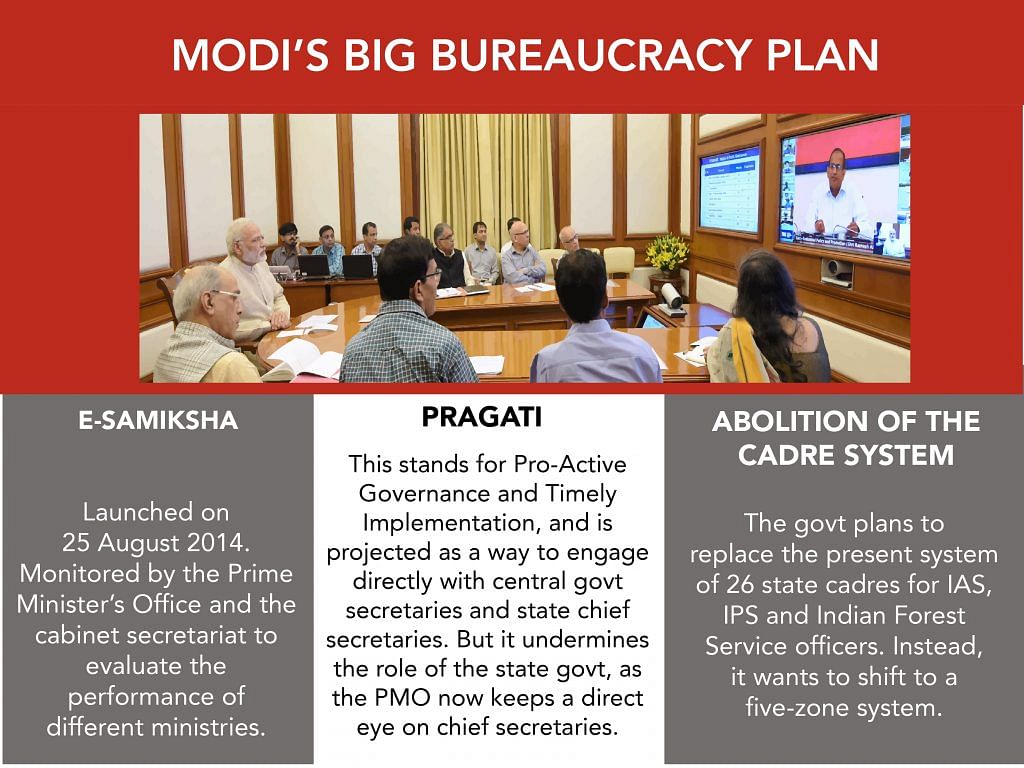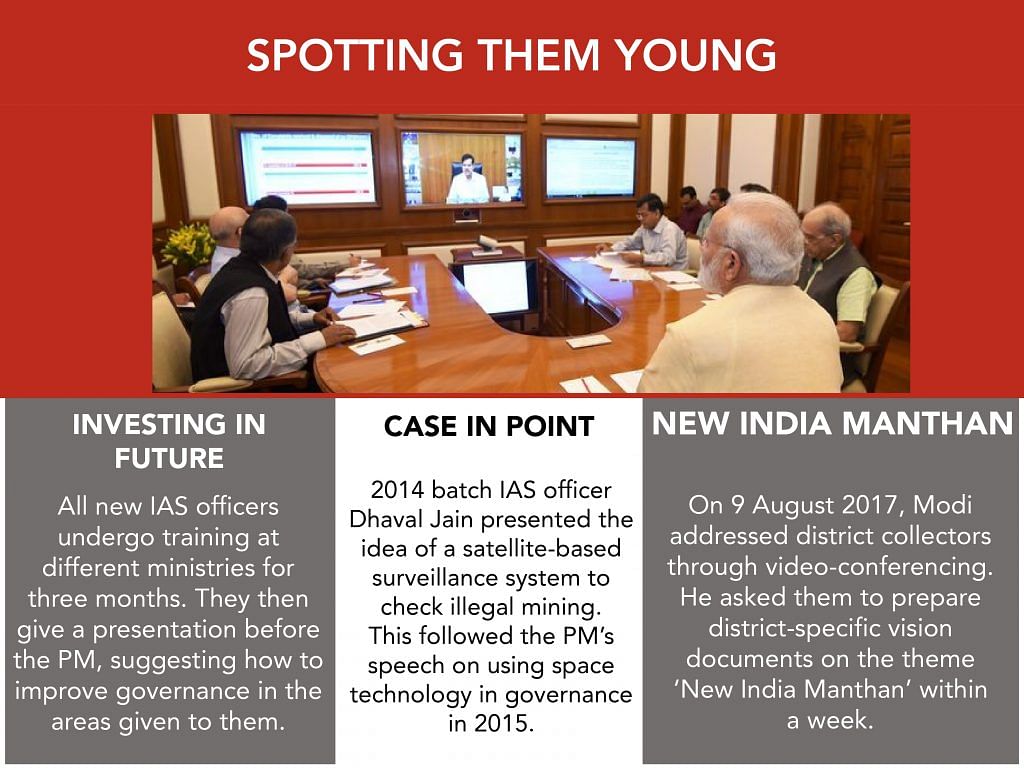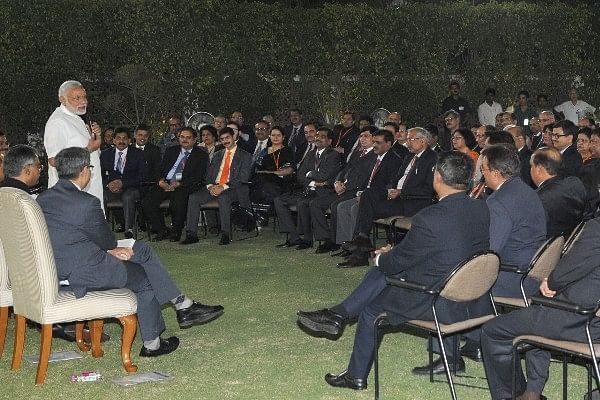PM Narendra Modi has begun reaching out directly to the bureaucracy, keeping tabs on their performance, and setting goals, for better implementation of his policies.
Around 6 pm on 23 August 2017, two Volvo buses were parked outside North Block on Raisina Hill, under the watchful eye of the Special Protection Group. The arrangement was to ferry 80 bureaucrats to the Prime Minister’s residence at 7 Lok Kalyan Marg.
The occasion was the first of five open house interactions between PM Narendra Modi and the second and third layer of the central government bureaucracy. In fact, it was the first such face-to-face interaction with officials other than secretaries to the Government of India and was the latest indication of the changing dynamic between the political leadership and the officers who actually run the show.
The cabinet secretary had primed the 80 bureaucrats – additional and joint secretaries – with a simple piece of advice prior to the meetings: raise no service matters, and avoid negativity.
What transpired over the next few hours bowled over most bureaucrats present. The PM heard out everyone – he was, in fact, keener on listening – and showed he was well informed about his government’s many schemes. He acknowledged concerns raised by the bureaucrats, and welcomed new proposals that were mooted directly to him in the meeting.
He offered the civil servants tea and snacks, and kept the spirits high with his sense of humour. “Waise to main kehta hun, na khaoonga, na khaane doonga…” he began, joking that he was making a special exception by inviting them to tea. He also observed that while many a PM would probably serve them a grand dinner, he himself ate little at night, and so, tea it would have to be.
Steering clear of lecturing the bureaucrats, the PM did share the mantra of breaking silos, and urged for efficient internal communication between government departments for speedy execution. He also asked for feedback on government projects, and asked every official to make a transformative action plan for a ‘New India’ by 2022.
Most bureaucrats who interacted with the PM came away with their view of him changed – far from a forbidding presence issuing directions and orders, Modi looked like someone who had an open mind, was willing to listen, and easy to talk to. That definitely did not seem the case back in 2014.
Disruptor-in-chief
The Modi government had come to power in 2014 with a clear and strong narrative – the bureaucracy had to be shaken out of its slumber, and be rid of the after-effects of a decade-long Congress-led government.
Bureaucrats viewed as ‘close’ to the previous dispensation were viewed with suspicion and systematically eased out of prominent positions, sudden repatriations were effected, and some ministers even went into open confrontation with bureaucrats they viewed as aligned to the ‘UPA ideology’.
A new work ethic was brought in – biometric attendance for every official meant early and minimum office working hours. For officials, these were hardly reasons to be enthused.
However, there were early signs of Modi’s style of functioning. On 4 June 2014, he called a meeting of all 77 secretaries of Union ministries and said just one thing – “Tell me how to run the government”.
For many secretaries, it was their first such meeting with the Prime Minister of India, and thereafter, they were given telephone numbers and email IDs and asked to be directly in touch with the PMO.
The UPA-era practice of forming Group of Ministers (GOM) and Empowered GOMs was let go, and instead, Committees of Secretaries were formed to resolve most interdepartmental issues.
Suddenly, the ministries and ministers diminished in the power play, with an all-powerful PMO directly talking to the top bureaucrats across the government – sometimes even without the knowledge of the minister in charge.
“There are times when local MLAs and influential leaders try to delay or divert the work project for vested interests,” says a senior official of the IAS association on the condition of anonymity. “Now, when they know that the highest office of the country is monitoring it directly, they don’t obstruct. After all every officer wants to do some good work in his area, as it would be better for his career.”
The new dynamic
In 2017, the PM is continuing the new dynamic he has established by reaching out to second- and third-layer officials too, bringing in a new equation of direct access.
“The Prime Minister understands the role of bureaucrats in the system. Be it policy-making or implementation, the onus lies heavily on bureaucrats,” says TSR Subramanian, former cabinet secretary. “I think he is just trying to tell them to play their role without any pressure.”
Satyanand Mishra, former secretary of the department of personnel and training, adds: “This is an unconventional way of doing business, when the PM directly interacts with officers at the bottom level to bring them in sync with his vision and delivery goals. It has more of a symbolic value – when the Prime Minister talks to officers directly, they feel empowered enough to perform their duties.”
There are, in fact, multiple moves being made to touch the various levels of the bureaucracy, including the new entrants into the system.


New talent, new ideas and their direct delivery are key to what Modi has set out to do with the steel frame of the Indian government.
The larger mission – Team Modi
So what is Modi’s ultimate endgame with all these exercises? The PM is looking to put in place a ‘Team Modi’ as things move toward 2019, and a possible second term beyond. He is picking out officers with a good track record over the last 8-10 years, and as well as plugging gaps by bringing in talent from outside. This ‘Team Modi’ is to ensure the speedy delivery of a range of governance mechanisms, and effective implementation of innovative ideas.
To ensure that the right men and women make Team Modi, new systems are being put in place, like the 360 degree feedback mechanism that was introduced in 2016.
Under this, at secretary and additional secretary level, the Annual Confidential Report (ACR) is not the only parameter to judge the performance of a senior officer. It includes a complete fact-check about the approach towards work and general behaviour of the individual officer, based on confidential reports from peers, subordinates, and even outsiders who have dealt with the officer.
Minimising lobbying influences, the ‘360’ created a situation where a number of senior officials were empanelled as secretary or additional secretary-equivalent posts and deputed to arguably less critical positions, while the best of the lot were given posts key to the Modi scheme of things. Even though it may have caused some heartburn, the ‘360’ is seen to have respected merit above all, so far.
This ‘Team Modi’ concept is not going to be limited to IAS officers. The Indian Police Service is next in line, as the PM deepens his reach to every level of governance, to get the right men and women in key posts of action.
These IAS, IPS, and Indian Forest Service officers must also have seen more than New Delhi and one state, so the government is planning to replace the existing cadre system in favour of a zonal system, whereby new officers can select a state from one of five zones.
The endgame is simple – to create a new bulwark of bureaucracy in sync with Vision Modi.
Also read: The Presidential Prime Minister Narendra Modi




Wonderful eye-opener giving us a glimpse into his vision for the country. Thank you so much for writing this.
May it be impossible to make the existing bureaucracy effective.As a pilot project a different approach is to be evolved,can implement if found good,in tune with the government policies.
Dictators do that!